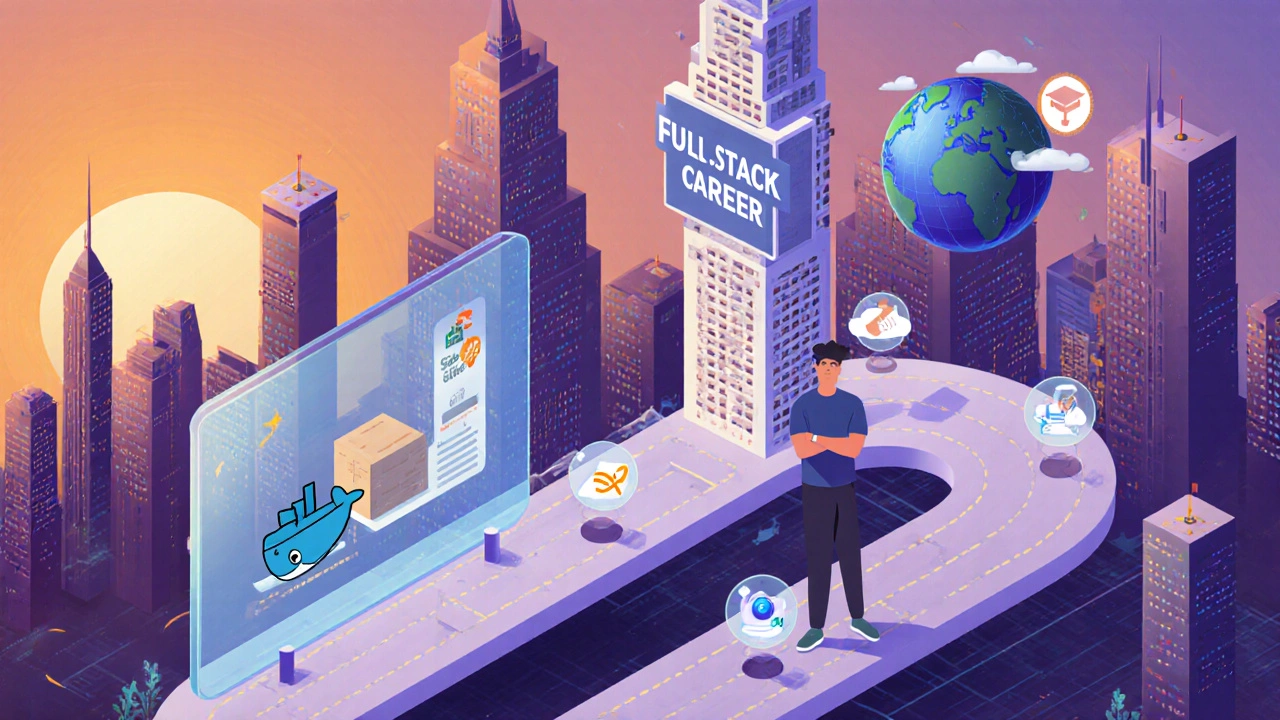Full-Stack Developer Career Calculator
Your Learning Path
Select your current skill level and preferred learning method
Bootcamp
Intensive, project-focused
$8k-$15k
Self-Study
Flexible, cost-effective
$0-$1.2k
University Degree
Theoretical depth
$30k-$80k
Your Personalized Plan
Job-Ready Timeline
Estimated time to market-ready skills
Key Considerations
Wondering if the window has slammed shut on a full-stack developer career? The tech landscape keeps shifting, but the demand for developers who can handle front‑end and back‑end tasks remains surprisingly strong. This guide breaks down the job market, the skill set you’ll need, and a realistic roadmap whether you’re fresh out of college or looking to pivot after a decade in another field.
Key Takeaways
- The full‑stack market is still growing, with a 12% YoY hiring increase in 2024.
- Age isn’t a barrier; experience and adaptability matter more.
- Focus on core languages (JavaScript and Python) and a modern framework.
- Choose a learning path that matches your schedule: bootcamps, self‑study, or a degree.
- Remote work expands opportunities globally, so you can compete beyond your local market.
Why Full‑Stack Development Still Matters
Full-stack developer is a role that blends front‑end UI creation with back‑end server logic, database management, and often DevOps basics. Companies value this blend because it reduces hand‑off friction and speeds up product cycles.
According to the 2025 Stack Overflow Developer Survey, 58% of respondents said they prefer hiring a developer who can navigate both ends of the stack. That translates into steady job postings on platforms like LinkedIn and Indeed, even for senior‑level positions.
Core Skill Landscape
To stay relevant, you need a solid foundation in a few key technologies.
- JavaScript - the lingua franca of the web. Mastering ES6+ syntax, asynchronous patterns, and tooling (npm, webpack) is non‑negotiable.
- Python - dominates the back‑end, data pipelines, and AI integrations. Knowing Flask or Django helps you spin up APIs quickly.
- Node.js - brings JavaScript to the server side, enabling a unified language stack.
- React - the most popular front‑end library for building interactive UIs. Understanding hooks, state management, and component composition is essential.
- Docker - containerization lets you ship code consistently across environments, a skill increasingly required for DevOps‑adjacent tasks.
- AWS (Amazon Web Services) - cloud platforms host the majority of modern applications. Knowing EC2, S3, and Lambda gives you a deployment edge.
Beyond these, familiarity with version control (Git), CI/CD pipelines, and API design (RESTful or GraphQL) rounds out a market‑ready profile.
Learning Paths Compared
| Aspect | Intensive Bootcamp | Self‑Study | Computer Science Degree |
|---|---|---|---|
| Time to Hireable Skill | 3-6 months | 6-24 months (varies) | 3-4 years |
| Cost (USD) | $8,000-$15,000 | $0-$1,200 (books, courses) | $30,000-$80,000 (tuition) |
| Depth of Theory | Practical, project‑focused | Depends on resources | Strong theoretical foundation |
| Job Support | Career services, network | Self‑driven networking | Campus recruiting, alumni |
| Best For | Career switchers, time‑pressed | Self‑motivated learners | Long‑term career planners |
Pick the path that matches your schedule, budget, and learning style. Many developers blend routes-taking a bootcamp for rapid skill acquisition while continuing self‑study to deepen theory.
Age, Experience, and the Myth of “Too Late”
Data from the U.S. Bureau of Labor Statistics shows the median age of software developers is 32, but the 95th percentile includes professionals in their late 50s. What matters is continuous learning, not the year you start.
If you already have a background in JavaScript from front‑end work, you can pivot to back‑end by adding Node.js and database knowledge (SQL or NoSQL). Existing domain expertise (e.g., finance, healthcare) often becomes a unique selling point when you can combine it with full‑stack abilities.
Employers care about your portfolio, problem‑solving mindset, and ability to ship features, not the date on your birth certificate. Highlighting personal projects, open‑source contributions, or freelance gigs can demonstrate up‑to‑date competence.

Salary Trends and Growth Outlook
Glassdoor’s 2025 salary report lists the average U.S. base pay for a full‑stack developer at $115,000, with senior roles climbing above $150,000. Remote roles often pay at parity with major tech hubs, meaning location is less of a limiting factor.
Projected hiring growth stands at 12% annually through 2028, driven by cloud migration, micro‑services adoption, and the rise of low‑code platforms that still need seasoned engineers to build custom extensions.
Specializing in high‑demand stacks-like React + Node.js or Python + AWS-can command premium rates, especially for contract or freelance work.
Actionable Roadmap for New Entrants
- Assess your current skill gap - list what you know in front‑end, back‑end, and DevOps.
- Pick a core language pair - most developers start with JavaScript (front) and Python (back).
- Complete a project that includes a REST API, a database, and a responsive UI. Deploy it on AWS using Docker containers.
- Document the project on GitHub, write a concise README, and share it on LinkedIn.
- Choose a learning path - bootcamp for speed, self‑study for cost, or degree for theory.
- Network: join local meetups (e.g., Dublin DevOps), online Discord channels, and contribute to open‑source.
- Apply for junior or mid‑level roles, tailoring your résumé to highlight full‑stack projects and any industry domain knowledge.
Following these steps keeps you moving forward, regardless of when you start.
Frequently Asked Questions
Is a previous degree required to become a full‑stack developer?
No. Many successful developers are self‑taught or completed short‑term bootcamps. What matters most is a demonstrable portfolio and the ability to solve real problems.
How long does it typically take to become job‑ready?
Intensive bootcamps can get you hireable in 3-6 months, while self‑study routes may take 6-24 months depending on time commitment.
Does remote work affect my chances?
Remote positions broaden the talent pool, letting you compete globally. Demonstrating effective communication and version‑control skills is key.
What is the best tech stack to learn in 2025?
A popular combination is React for the front‑end, Node.js or Python for the back‑end, containerized with Docker, and hosted on AWS. This stack covers most modern web app requirements.
Can I switch to full‑stack at 40+ years old?
Absolutely. Companies value life experience and soft‑skills. Pair your existing domain knowledge with up‑to‑date coding practice, and you’ll be a strong candidate.
